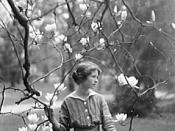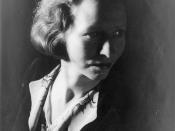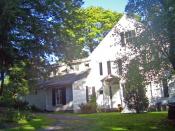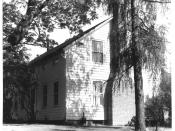Harley Gregory Eh 252 American Lit. 2 Edna St. Vincent Millay Edna St. Vincent Millay was born in 1892, in Rockland, Maine, to Cora Buzzelle Millay and Henry Tolman Millay. Edna Millay received her name in a very interesting way. To begin with, her parents were confident that she would be born a boy and decided to name her after St. Vincent, patron saint of the sick and the wine growers. Her mother decided to name her St. Vincent after receiving the news that her younger brother, whom had been seriously injured during a storm at sea, was recovering under the superb care given to him at St. Vincent's Hospital (Gould 3). When Millay was around the age of eight, despite the all of the taboo, her parents filed for a divorce. Under the influence of her mother, Edna Millay began writing prose during the years of her early childhood.
At the age of nineteen, Millay wrote "Renascence,"ÃÂ which is considered her first major work. As a result, Millay earned herself a scholarship to Vassar College. While she was studying at Vassar, she continued to write and publish her poetry.
After her graduation, Millay took up residence in the New York borough of Greenwich Village, a noted haven for people of artistic sensibilities as well as a center for issues of women's rights and free love. In the 1920s, Millay's lifestyle caught up with her and she had a nervous breakdown. Due to her ill health, she was forced to move to Europe for two years. Then in 1924, Edna St. Vincent Millay married businessman Eugen Boissevain. Eugen allowed Edna to concentrate on her work, which enabled her to win the Pulitzer Prize in 1923 and was granted an honorary degree from Tufts University in 1925. Millay died of a heart attack at her home in Austerlitz, New York, on October 19, 1950.
I was able to locate a complete list of Edna Millay's works in the Critical Survey of Poetry, which was a very useful resource. Millay's first major work of poetry is considered to be "Renascence and Other Poems,"ÃÂ which was published in 1917. A Few Figs from Thistles, Second April, and The Harp-Weaver and Other Poems were all published in the early 1920s. Following these works were The Buck in the Snow and Other Poems and Edna St. Vincent Millay's Poems Selected for Young People, which were published in the late 1920s. Beginning in the early 1940s, she wrote the following poems: Make Bright Arrows, Invocation of the Muses, Collected Lyrics, and Collected Poems. She also wrote several plays, the most successful being the first, Aria da Capo, first produced in 1919, followed by The Lamp and the Bell and Two Slatterns and a King, published in 1921 (Magill 2321).
Much of Millay's poetry, particularly that written during the early 1920s, has been characterized as an effective representation of the atmosphere of the Jazz Age. She portrayed an image of independence and rebellion to her audience. In this time period her poetry also playfully denigrated social conventions by depicting women who remained single and casual in love relationships. Many perceive Millay's verse as being light-hearted and brash, although many of her poems are deeply introspective. For example, "Renascence"ÃÂ expresses the poet's spiritual awakening and is noted for its vivid nature imagery and its childlike tone. Millay excelled in the form of the sonnet; which is where philosophical, political, and social themes, as well as the frank acknowledgement of emotion are ever-present.
Mary M. Colum, who was called "the best woman critic in America,"ÃÂ sees Edna St. Vincent Millay as America's sweetheart in the nineteen twenties. To Colum, Millay was one of the rare writers that was able to strike the hearts of her readers, and one of the first women in literature to wholeheartedly back up the male dominant ideas of her time. She was discussed in various social groups. She also became a great interest to other writers such as Thomas Hardy and W. B. Yeats. The unconventional ideas that Millay expressed in her writing was probably a wonderful topic of discussion. Colum continues to claim that Millay was not sufficiently educated, which injured her self-criticism. James Gray, and American playwright and critic, has the opinion that, "seen as whole [Millay] emerges out of myth not as a gay figure but as a tragic one; not as a precocious perennial schoolgirl but as an artist born mature and burdened with a scrupulous sense of responsibility toward her gift"ÃÂ (Kalasky 220).
Millay had some life changing experiences that influenced here poetry. Her parents got a divorce when she was a young girl, which made her a little insecure, this had a big effect on her writing. Also, I think that through her poetry she was able to express the events of her life and the way she felt about standing strong through the good times and the bad times. She also had some mental problems, such as nervous break downs, these break downs made here insecure with life and she found comfort in her husband and her poetry. I appreciate her poetry because she wrote about politics and World War II instead of writing about her own life she wrote to help others understand the war. She is easier to understand than most poets because she writes simple poetry because she writes on subjects that are important to her so that her emotions are portrayed. I conclude that Millay's poetry is an attribute of her life and the problems she endured .
Works Citied Napierkowski, Marie Rose, and Mary K. Ruby, eds. Poetry for Students. Vol. 3. Detroit: Gale, 1998. 78-88.
Kalasky, Drew, ed. Poetry Criticism. Vol. 6. Detroit: Gale Research Inc, 1993. 203-227.
Magill, Frank N. , ed. Critical Survey of Poetry: English Language Series. Vol. 5. Pasadena: Salem Press, 1992. 2321-2328.





